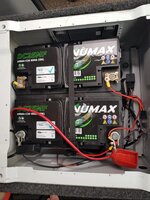Halfpint 19
Free Member
- May 20, 2021
- 6
- 0
- Funster No
- 81,366
- MH
- Rjmkbsra19
New to motorhoming and trying to get my head round the battery ie volts/amp hours. Came home from week away and then plugged into mains to get the Amp hours up again for the weekend. Nothing at all switched on taking power, but the amp hours showing on control panel are still slightly dropping instead of increasing. Its gone from 40 to 38. There is mains power getting through as i can work the microwave. Any idea what i am doing wrong?



